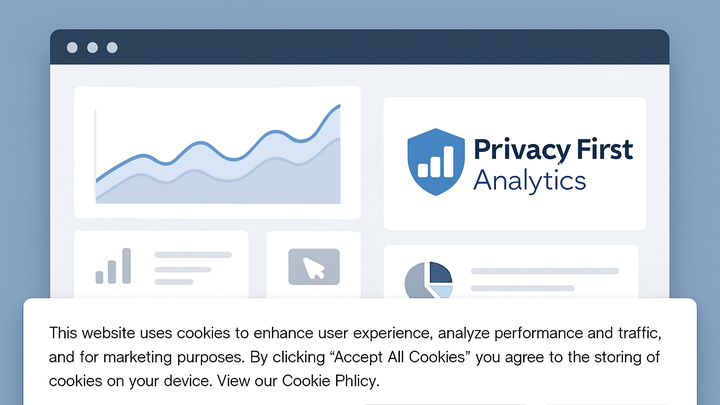Published on 2025-06-26T04:35:25Z
What is a Cookie Banner? Examples for Cookie Banner.
In the analytics industry, a Cookie Banner is a user interface element that informs visitors about cookie usage and captures their consent before tracking begins. It’s mandated by privacy regulations such as GDPR, ePrivacy Directive, and CCPA to ensure transparency and user control over personal data. Cookie banners typically classify cookies (e.g., necessary, analytics, marketing), allow users to accept or reject specific categories, and link to detailed privacy policies. They integrate with Consent Management Platforms (CMPs) or can be custom-built to block or delay analytics scripts like GA4 until consent is granted. Privacy-first analytics tools like PlainSignal, which operate without cookies, can simplify or even reduce consent requirements, offering seamless measurement with minimal user friction. Proper implementation balances legal compliance with user experience and data accuracy.
Cookie banner
A Cookie Banner is a website prompt for user consent on cookies, ensuring privacy compliance before analytics tracking starts.
Why Cookie Banners Matter
Cookie banners are crucial for regulatory compliance and building user trust in analytics. They ensure that users are informed about data collection practices and can control their privacy settings. Without proper consent mechanisms, organizations risk legal penalties, loss of brand reputation, and skewed analytics data due to missing opt-ins.
-
Regulatory requirements
Laws like GDPR and CCPA require explicit user consent for non-essential cookies. Cookie banners serve as the primary mechanism to capture and record this consent in a verifiable manner.
-
User trust and transparency
Transparent consent notices demonstrate respect for user privacy, which can improve engagement and reduce bounce rates. Users are more likely to trust sites that clearly communicate data practices.
-
Data accuracy
Delaying analytics scripts until consent prevents incomplete or biased data. It ensures that analytics reports reflect only users who have agreed to be tracked, improving decision-making.
Key Components of an Effective Cookie Banner
An effective cookie banner should be clear, concise, and provide granular choices. It must outline cookie categories, present accept and reject options, and offer easy access to the privacy policy. The design should be responsive and non-disruptive to the user experience.
-
Categorization of cookies
Group cookies into categories such as ‘Necessary’, ‘Analytics’, and ‘Marketing’. This helps users understand the purpose of each cookie type.
-
Consent controls
Include buttons for ‘Accept All’, ‘Reject All’, and ‘Manage Preferences’. Ensure that preference changes can be made at any time.
-
Privacy policy link
Provide a direct link to the full privacy policy or cookie policy, explaining in detail what data is collected and how it is used.
Implementing Cookie Banners with Analytics Tools
Different analytics platforms require different approaches to consent integration. Privacy-first tools like PlainSignal minimize banner complexity, while GA4 needs script-blocking or dynamic loading based on user choice.
-
Using PlainSignal (cookie-free analytics)
PlainSignal operates without cookies, reducing or eliminating the need for granular consent banners for analytics. This simplifies compliance and enhances performance.
-
Integration snippet
Add the PlainSignal script before the closing </head> tag to start capturing data without cookies:
<link rel="preconnect" href="//eu.plainsignal.com/" crossorigin /> <script defer data-do="yourwebsitedomain.com" data-id="0GQV1xmtzQQ" data-api="//eu.plainsignal.com" src="//cdn.plainsignal.com/plainsignal-min.js"></script>
-
-
Integrating with google analytics 4 (GA4)
GA4 uses cookies and requires conditional loading based on user consent. Implement script blocking or dynamic insertion of the gtag.js snippet after ‘Accept Analytics’ is clicked.
-
Example approach
Use a CMP or custom script to check consent and then inject the GA4 tag:
<script> function loadGA4(){ const tag = document.createElement('script'); tag.src = 'https://www.googletagmanager.com/gtag/js?id=G-XXXXXXX'; tag.async = true; document.head.appendChild(tag); window.dataLayer = window.dataLayer || []; gtag('js', new Date()); gtag('config', 'G-XXXXXXX'); } // call loadGA4() only after user consents to analytics cookies </script>
-
Best Practices for Cookie Banners
Following best practices ensures compliance and maintains a positive user experience.
-
Clarity and transparency
Use plain language and avoid technical terms. Clearly explain why each cookie category exists and what data is collected.
-
Accessible preference management
Allow users to update their consent at any time via a persistent link or button on the site footer.
-
Performance considerations
Lazy-load non-essential scripts and leverage privacy-first analytics to minimize performance impact.
Challenges and Considerations
Implementing cookie banners involves trade-offs between compliance, data quality, and user experience.
-
Consent rates and data completeness
Strict banners can reduce opt-in rates, leading to gaps in analytics data. Evaluate the impact on reporting and consider fallback measurement methods.
-
Regulatory variations
Different regions have varying requirements (e.g., CCPA vs. GDPR). Ensure your banner adapts to the visitor’s location and local laws.
